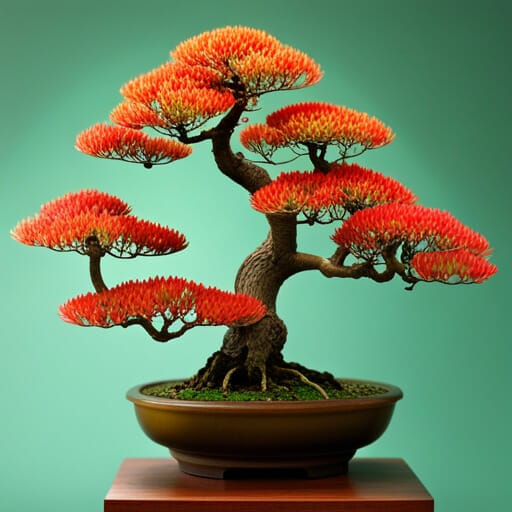Bonsai trees, miniature representations of fully grown trees found in nature, hold deep symbolism and are revered for their ability to convey peace, harmony, and steady growth.
These tiny trees, derived from the Japanese words Bon (pot or container) and Sai (plants), symbolize the struggle of a tree against natural forces and reflect the principles of Zen Buddhism.
With their intricate designs and various styles, such as formal upright, cascade style, and windswept style, bonsai showcases the beauty and artistry of nature in a miniature form.
The creation and care of bonsai requires time and effort, making it a symbol of wealth and success.
Emphasizing simplicity, aesthetics, and order of thought, bonsai serves as a reminder to grow slowly and steadily in our own lives.
In this article, we will explore the symbolism of bonsai, its connection to Zen Buddhism, and the different styles that exemplify its beauty and artistry.
Contents
Quick Points
- Bonsai symbolizes peace, harmony, and steady growth.
- Bonsai reflects the struggle of a tree against natural forces and the principles of Zen Buddhism.
- Bonsai serves as a reminder to grow slowly and steadily in our own lives.
– The connection between bonsai and Zen Buddhism promotes living in the present moment and finding inner peace.
The Symbolic Meaning

The symbolic meaning of bonsai is reflected in its representation of peace, harmony, and steady growth, aligning with its association with Zen Buddhism and the natural forces that trees struggle against.
Bonsai symbolizes peace by capturing the essence of tranquility and stillness found in nature. It serves as a reminder to find inner peace amidst the chaos of life.
Harmony is symbolized through the balance and aesthetic beauty of bonsai, mirroring the harmony found in nature.
The steady growth of bonsai represents the importance of patience and perseverance in achieving personal growth and success. It serves as a reminder that progress takes time and that slow and steady steps lead to lasting achievements.
Bonsai’s symbolic meaning not only reflects the principles of Zen Buddhism but also serves as a guiding force for individuals seeking peace, harmony, and steady growth in their lives.
The Connection to Zen Buddhism

Connected to Zen Buddhism, the art of bonsai reflects the principles of simplicity, patience, and mindfulness in its cultivation and care. Zen Buddhism emphasizes the importance of being present in the moment and finding tranquility within oneself. Similarly, bonsai cultivation requires a deep level of concentration and focus, as each delicate branch and leaf must be meticulously shaped and pruned. This process encourages practitioners to slow down and appreciate the beauty of nature, promoting a sense of inner peace and harmony.
Furthermore, the steady growth of bonsai trees mirrors the gradual progress and self-improvement that is valued in Zen Buddhism. By nurturing and tending to these miniature trees, individuals are reminded to cultivate their own personal growth and development in a patient and mindful manner.
Overall, the connection between bonsai and Zen Buddhism serves as a reminder to live in the present moment and find peace within oneself.
Different Styles of Bonsai

Different styles of bonsai showcase the artistry and creativity of practitioners, with the formal upright style being the most popular, accounting for approximately 45% of bonsai styles. Each style represents a unique aesthetic and requires specific techniques to achieve the desired effect.
Here are four notable bonsai styles:
- Informal Upright Style: This style mimics the natural growth of a tree, with a slightly curved trunk and branches that are not perfectly symmetrical.
- Cascade Style: In this style, the trunk of the bonsai cascades downwards, creating a sense of movement and flow. The branches also hang down, resembling a tree growing on a steep cliff.
- Windswept Style: This style depicts a tree that has endured strong winds, with its trunk and branches bending in one direction, creating a sense of resilience and strength.
- Literati Style: Also known as the ‘bunjin’ style, this style features a tall and slender trunk with sparse foliage, evoking a sense of elegance and simplicity.
These various styles allow bonsai enthusiasts to express their creativity and showcase the beauty of nature in miniature form.
Frequently Asked Questions
How do you care for a bonsai tree?
Caring for a bonsai tree involves providing the right conditions such as proper sunlight, watering, and soil. Pruning and shaping the tree regularly is essential for its health and aesthetics. Additionally, protecting it from pests and diseases is crucial for its longevity.
What are the benefits of having a bonsai tree?
Having a bonsai tree offers several benefits. It can bring a sense of peace and harmony to the environment, as well as serve as a reminder of the importance of steady growth and balance in life.
Can bonsai trees be grown indoors?
Bonsai trees can be grown indoors, providing a sense of tranquility and connection with nature. Their miniature form and delicate care required make them a metaphor for personal growth and the importance of nurturing our own well-being.
How long does it take for a bonsai tree to reach its desired shape?
The time it takes for a bonsai tree to reach its desired shape depends on various factors, such as the species of tree, its age, and the techniques used. Generally, it can take several years to decades of careful pruning, wiring, and training to achieve the desired form.
Are there any specific bonsai tree species that are considered more symbolic than others?
There are no specific bonsai tree species that are considered more symbolic than others. The symbolism of bonsai lies in its overall representation of peace, harmony, and steady growth, rather than in the specific species used.




